Departments of Burkina Faso

 |
| This article is part of a series on the politics and government of Burkina Faso |
|
Parliament |
The provinces of Burkina Faso are divided into 351 departments (as of 2014 and since local elections of 2012), whose urbanized areas (cities, towns and villages) are grouped into the same commune (municipality) with the same name as the department (the department also covers rural areas, including national natural parks, that are not ruled locally at municipal level, but by the state at departmental level). The 351 communes created in those departments have three kinds of status :
- 49 urban communes (including 2 urban communes with special status, the Ouagadougou and Bobo-Dioulasso departments that are further subdivided into "arrondissements"), are grouping their main city/town (subdivided into urban sectors) and all other administrative villages in their department ; in these 49 urban communes, the main city or town is subdivided into urban sectors (within the two communes with special status, each urban sector of the capital city belong to only one arrondissement, which may also include other surrounding villages outside the capital city) — these 49 urban communes include the capital town (or city) of each one of the 45 provinces, and the commune of 4 additional departments, whose capitals are now large towns covering their respective urban areas (subdivided into urban sectors rather than former separate villages) : Bittou, Garango, Niangoloko and Pouytenga.
- 302 rural communes are grouping all administrative villages in their department.[1][2]
Departments (or communes) generally have the same name as their capital city or town, with a few exceptions (for historical reasons). For the local elections in 2012, communes were created in each department that still did not have one (village councils were kept but operate at advisory level under the supervision of their commune: each administrative village or urban sector elects at least 2 seats in the municipal council of their commune; for other elections at regional or national level, the smallest electoral circonscription is the whole department). The departments (or communes) are listed below, by province:
List of departments by region and by province
Boucle du Mouhoun Region
Balé
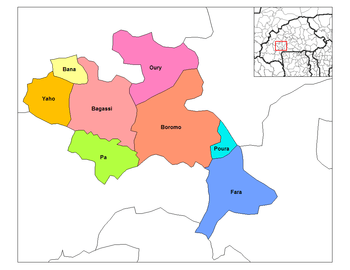
- Bagassi Department
- Bana Department
- Boromo Department
- Fara Department
- Oury Department
- Pâ Department
- Pompoï Department
- Poura Department
- Siby Department
- Yaho Department
Banwa

- Balavé Department
- Kouka Department
- Sami Department
- Sanaba Department
- Solenzo Department
- Tansila Department
Kossi

- Barani Department
- Bomborokui Department
- Djibasso Department
- Dokuy Department
- Doumbala Department
- Kombori Department
- Madouba Department
- Nouna Department
- Bourasso Department (newly created)
- Sono Department (newly created)
Mouhoun
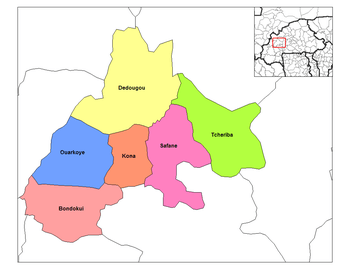
- Bondokuy Department
- Dédougou Department
- Douroula Department
- Kona Department
- Ouarkoye Department
- Safané Department
- Tchériba Department
Nayala

- Gassam Department
- Gossina Department
- Kougny Department
- Toma Department
- Yaba Department
- Yé Department
Sourou

- Di Department
- Gomboro Department
- Kassoum Department
- Kiembara Department
- Lanfièra Department
- Lankoué Department
- Toéni Department
- Tougan Department
Cascades Region
Comoé

- Banfora Department
- Bérégadougou Department
- Mangodara Department
- Moussodougou Department
- Niangoloko Department
- Ouo Department
- Sidéradougou Department
- Soubakaniédougou Department
- Tiéfora Department
Léraba
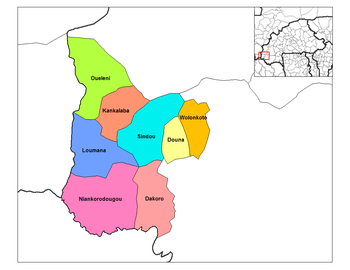
- Dakoro Department
- Douna Department
- Kankalaba Department
- Loumana Department
- Niankorodougou Department
- Ouéléni Department
- Sindou Department
- Wolonkoto Department
Centre Region
Kadiogo

- Komki-Ipala Department
- Komsliga Department
- Koubri Department
- Ouagadougou Department (formerly Kadiogo Department)
- Pabré Department
- Saaba Department
- Tanghin-Dassouri Department
Centre-Est Region
Boulgou
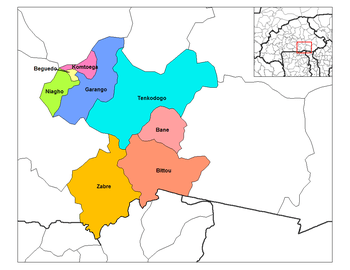
- Bagré Department
- Bané Department
- Béguédo Department
- Bittou Department
- Boussouma Department
- Garango Department
- Komtoèga Department
- Niaogho Department
- Tenkodogo Department
- Zabré Department
- Zoaga Department
- Zonsé Department
- Bissiga Department (newly created)
Koulpélogo

- Comin-Yanga Department
- Dourtenga Department
- Lalgaye Department
- Ouargaye Department
- Sangha Department
- Soudougui Department
- Yargatenga Department
- Yondé Department
Kouritenga

- Andemtenga Department
- Baskouré Department
- Dialgaye Department
- Gounghin Department
- Kando Department
- Koupéla Department
- Pouytenga Department
- Tensobtenga Department
- Yargo Department
Centre-Nord Region
Bam
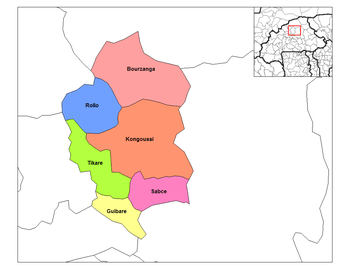
- Bourzanga Department
- Guibaré Department
- Kongoussi Department
- Nasséré Department
- Rollo Department
- Rouko Department
- Sabcé Department
- Tikaré Department
- Zimtenga Department
Namentenga
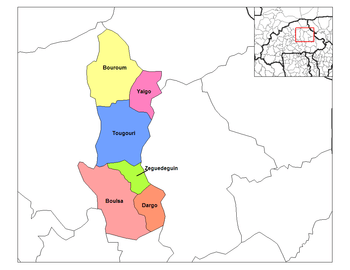
- Boulsa Department
- Bouroum Department
- Dargo Department
- Tougouri Department
- Yalgo Department
- Zéguédéguin Department
- Nagbingou Department (newly created)
Sanmatenga
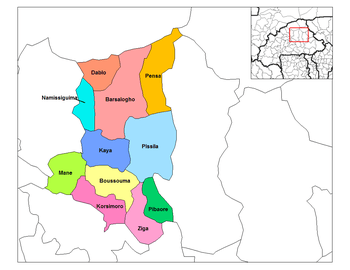
- Barsalogho Department
- Boussouma Department
- Dablo Department
- Kaya Department
- Korsimoro Department
- Mané Department
- Namissiguima Department
- Pensa Department
- Pibaore Department
- Pissila Department
- Ziga Department
Centre-Ouest Region
Boulkiemdé

- Bingo Department
- Imasgo Department
- Kindi Department
- Kokologho Department
- Koudougou Department
- Nanoro Department
- Pella Department
- Poa Department
- Ramongo Department
- Sabou Department
- Siglé Department
- Sourgou Department
- Thyou Department
- Nandiala Department (newly created)
- Soaw Department (newly created)
Sanguié

- Dassa Department
- Didyr Department
- Godyr Department
- Kordié Department
- Kyon Department
- Pouni Department
- Réo Department
- Ténado Department
- Zawara Department
- Zamo Department (newly created)
Sissili
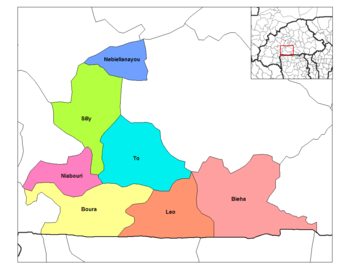
- Biéha Department
- Boura Department
- Léo Department
- Nébiélianayou Department
- Niabouri Department
- Silly Department
- Tô Department
Ziro
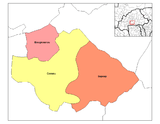
- Bakata Department
- Bougnounou Department
- Cassou Department
- Dalo Department
- Gao Department
- Sapouy Department
Centre-Sud Region
Bazèga

- Doulougou Department
- Ipelcé Department
- Kayao Department
- Kombissiri Department
- Saponé Department
- Toécé Department
- Gaongo Department (newly created)
Nahouri

Zoundwéogo
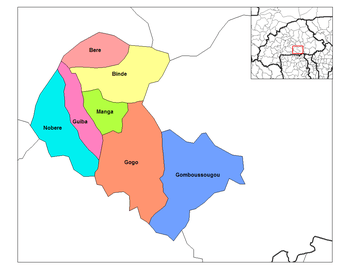
- Béré Department
- Bindé Department
- Gogo Department
- Gomboussougou Department
- Guiba Department
- Manga Department
- Nobére Department
Est Region
Gnagna

- Bilanga Department
- Bogandé Department
- Coalla Department
- Liptougou Department
- Manni Department
- Piéla Department
- Thion Department
Gourma
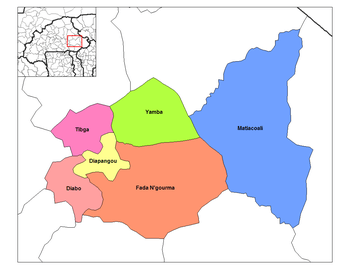
- Diabo Department
- Diapangou Department
- Fada N'gourma Department
- Matiacoali Department
- Tibga Department
- Yamba Department
Komondjari

- Bartiébougou Department
- Foutouri Department
- Gayéri Department
Kompienga
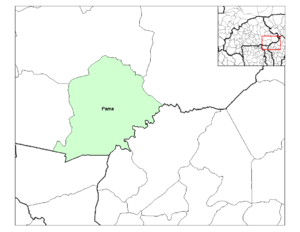
- Kompienga Department
- Madjoari Department
- Pama Department
Tapoa
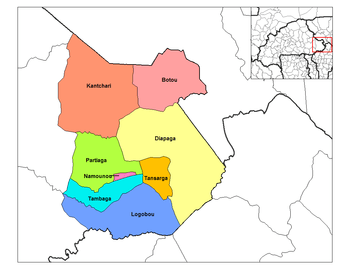
- Botou Department
- Diapaga Department
- Kantchari Department
- Logobou Department
- Namounou Department
- Partiaga Department
- Tambaga Department
- Tansarga Department
Hauts-Bassins Region
Houet
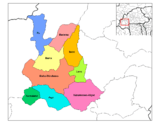
- Bobo-Dioulasso Department
- Bama Department
- Dandé Department
- Faramana Department
- Fô Department
- Karankasso-Sambla Department
- Karankasso-Vigué Department
- Koundougou Department
- Léna Department
- Padéma Department
- Péni Department
- Satiri Department
- Toussiana Department
Kénédougou

- Djigouéra Department
- Koloko Department
- Kourignon Department
- Kourouma Department
- Morolaba Department
- N'dorola Department
- Orodara Department
- Samoghohiri Department
- Samorogouan Department
- Sindou Department
- Banzon Department (newly created)
- Kangala Department (newly created)
- Kayan Department (newly created)
Tuy
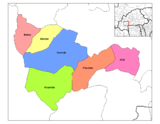
- Bekuy Department
- Béréba Department
- Boni Department
- Founzan Department
- Houndé Department
- Koti Department
- Koumbia Department
Nord Region
Loroum

Passoré
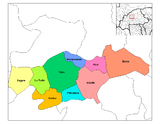
- Arbollé Department
- Bagaré Department
- Bokin Department
- Gomponsom Department
- Kirsi Department
- Lâ-Todin Department
- Pilimpikou Department
- Samba Department
- Yako Department
Yatenga
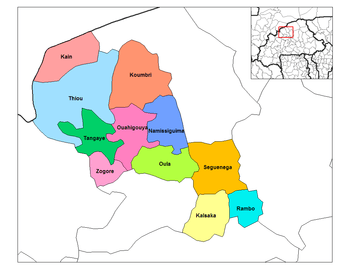
- Kaïn Department
- Kalsaka Department
- Koumbri Department
- Namissiguima Department
- Ouahigouya Department
- Oula Department
- Rambo Department
- Séguénéga Department
- Tangaye Department
- Thiou Department
- Zogore Department
- Barga Department (newly created)
- Kossouka Department (newly created)
Zondoma
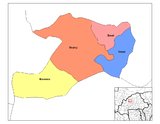
- Bassi Department
- Boussou Department
- Gourcy Department
- Léba Department
- Tougo Department
Plateau-Central Region
Ganzourgou

- Boudry Department
- Kogho Department
- Méguet Department
- Mogtédo Department
- Zam Department
- Zorgho Department
- Zoungou Department
- Salogo Department (newly created)
Kourwéogo
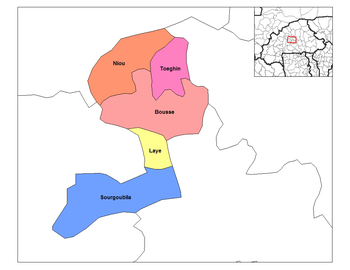
Oubritenga
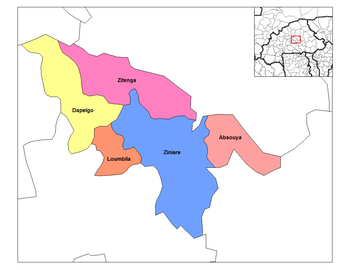
- Absouya Department
- Dapélogo Department
- Loumbila Department
- Ziniaré Department
- Zitenga Department
- Nagréongo Department (newly created)
- Ourgou-Manéga Department (newly created)
Sahel Region
Oudalan
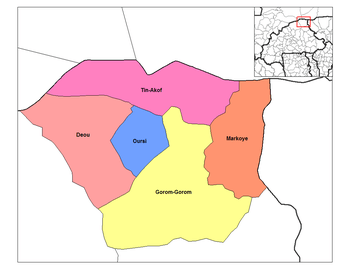
Séno

- Bani Department
- Dori Department
- Falagountou Department
- Gorgadji Department
- Sampelga Department
- Seytenga Department
Soum
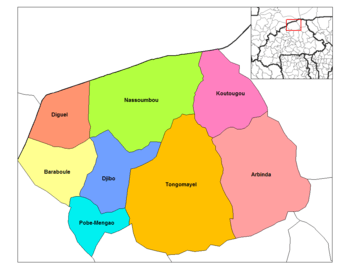
- Arbinda Department
- Baraboulé Department
- Diguel Department
- Djibo Department
- Koutougou Department
- Nassamfou Department
- Pobé-Mengao Department
- Tongomayel Department
- Kelbo Department (newly created)
Yagha

- Boundoré Department
- Mansila Department
- Sebba Department
- Solhan Department
- Tankougounadié Department
- Titabé Department
Sud-Ouest Region
Bougouriba
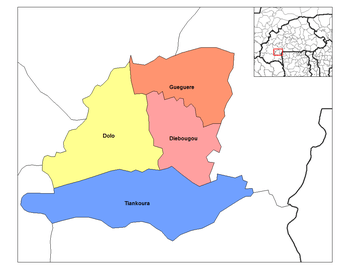
Ioba

- Dano Department
- Dissin Department
- Koper Department
- Niego Department
- Oronkua Department
- Ouessa Department
- Zambo Department
- Gueguere Department (newly created)
Noumbiel
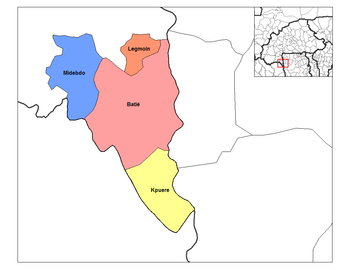
- Batié Department
- Kpuére Department
- Legmoin Department
- Midebdo Department
- Boussoukoula Department (newly created)
Poni
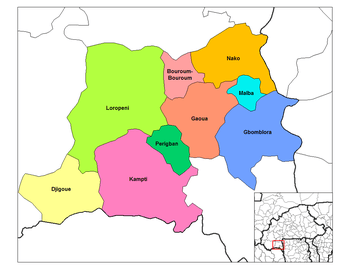
- Bouroum-Bouroum Department
- Djigoué Department
- Gaoua Department
- Gbomblora Department
- Kampti Department
- Loropéni Department
- Malba Department
- Nako Department
- Périgban Department
- Boussera Department (newly created)
References
- ↑ (French) Résultats préliminaires du RGPH 2006, INSD.BF (non-consolidated figures of legal population by village or urban sector)
- ↑ (French) Mémorandum sur la détermination du nombre de sièges des conseillers municipaux par village et par secteur dans le cadre des élections locales du 2 décembre 2012, CENI.BF (consolidated figures of legal population by village or urban sector, based on RGPH 2006, modified in 2012 including for newly created administrative villages).
